Soumya Kundu
Who should I trust? A Visual Analytics Approach for Comparing Net Load Forecasting Models
Jul 31, 2024

Abstract:Net load forecasting is crucial for energy planning and facilitating informed decision-making regarding trade and load distributions. However, evaluating forecasting models' performance against benchmark models remains challenging, thereby impeding experts' trust in the model's performance. In this context, there is a demand for technological interventions that allow scientists to compare models across various timeframes and solar penetration levels. This paper introduces a visual analytics-based application designed to compare the performance of deep-learning-based net load forecasting models with other models for probabilistic net load forecasting. This application employs carefully selected visual analytic interventions, enabling users to discern differences in model performance across different solar penetration levels, dataset resolutions, and hours of the day over multiple months. We also present observations made using our application through a case study, demonstrating the effectiveness of visualizations in aiding scientists in making informed decisions and enhancing trust in net load forecasting models.
Clustering Interval Load with Weather to Create Scenarios of Behind-the-Meter Solar Penetration
Mar 08, 2024Abstract:Forecasting load at the feeder level has become increasingly challenging with the penetration of behind-the-meter solar, as this self-generation (also called total generation) is only visible to the utility as aggregated net-load. This work proposes a methodology for creation of scenarios of solar penetration at the feeder level for use by forecasters to test the robustness of their algorithm to progressively higher penetrations of solar. The algorithm draws on publicly available observations of weather \emph{condition} (e.g., rainy/cloudy/fair) for use as proxies to sky clearness. These observations are used to mask and weight the interval deviations of similar native usage profiles from which average interval usage is calculated and subsequently added to interval net generation to reconstruct interval total generation. This approach improves the estimate of annual energy generation by 23\%; where the net generation signal currently only reflects 52\% of total annual generation, now 75\% is captured via the proposed algorithm. This proposed methodology is data driven and extensible to service territories which lack information on irradiance measurements and geo-coordinates.
Forte: An Interactive Visual Analytic Tool for Trust-Augmented Net Load Forecasting
Nov 10, 2023

Abstract:Accurate net load forecasting is vital for energy planning, aiding decisions on trade and load distribution. However, assessing the performance of forecasting models across diverse input variables, like temperature and humidity, remains challenging, particularly for eliciting a high degree of trust in the model outcomes. In this context, there is a growing need for data-driven technological interventions to aid scientists in comprehending how models react to both noisy and clean input variables, thus shedding light on complex behaviors and fostering confidence in the outcomes. In this paper, we present Forte, a visual analytics-based application to explore deep probabilistic net load forecasting models across various input variables and understand the error rates for different scenarios. With carefully designed visual interventions, this web-based interface empowers scientists to derive insights about model performance by simulating diverse scenarios, facilitating an informed decision-making process. We discuss observations made using Forte and demonstrate the effectiveness of visualization techniques to provide valuable insights into the correlation between weather inputs and net load forecasts, ultimately advancing grid capabilities by improving trust in forecasting models.
KPF-AE-LSTM: A Deep Probabilistic Model for Net-Load Forecasting in High Solar Scenarios
Mar 05, 2022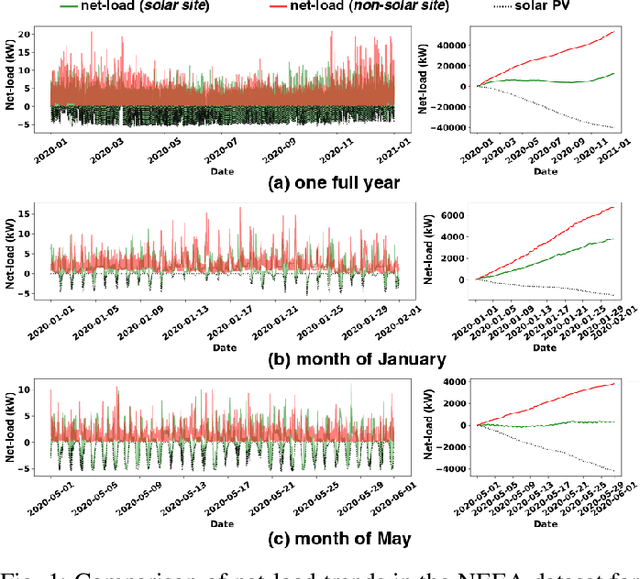



Abstract:With the expected rise in behind-the-meter solar penetration within the distribution networks, there is a need to develop time-series forecasting methods that can reliably predict the net-load, accurately quantifying its uncertainty and variability. This paper presents a deep learning method to generate probabilistic forecasts of day-ahead net-load at 15-min resolution, at various solar penetration levels. Our proposed deep-learning based architecture utilizes the dimensional reduction, from a higher-dimensional input to a lower-dimensional latent space, via a convolutional Autoencoder (AE). The extracted features from AE are then utilized to generate probability distributions across the latent space, by passing the features through a kernel-embedded Perron-Frobenius (kPF) operator. Finally, long short-term memory (LSTM) layers are used to synthesize time-series probability distributions of the forecasted net-load, from the latent space distributions. The models are shown to deliver superior forecast performance (as per several metrics), as well as maintain superior training efficiency, in comparison to existing benchmark models. Detailed analysis is carried out to evaluate the model performance across various solar penetration levels (up to 50\%), prediction horizons (e.g., 15\,min and 24\,hr ahead), and aggregation level of houses, as well as its robustness against missing measurements.
Developing and Validating Semi-Markov Occupancy Generative Models: A Technical Report
Dec 21, 2021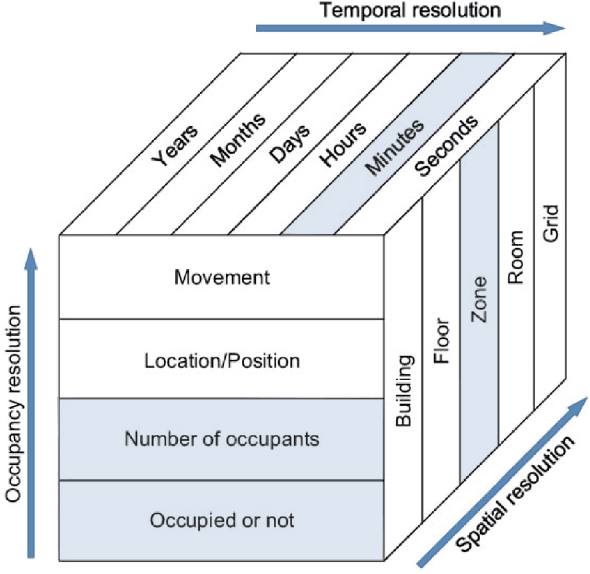

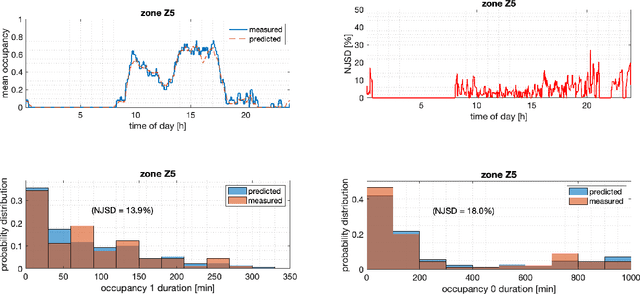

Abstract:This report documents recent technical work on developing and validating stochastic occupancy models in commercial buildings, performed by the Pacific Northwest National Laboratory (PNNL) as part of the Sensor Impact Evaluation and Verification project under the U.S. Department of Energy (DOE) Building Technologies Office (BTO). In this report, we present our work on developing and validating inhomogeneous semi-Markov chain models for generating sequences of zone-level occupancy presence and occupancy counts in a commercial building. Real datasets are used to learn and validate the generative occupancy models. Relevant metrics such as normalized Jensen-Shannon distance (NJSD) are used to demonstrate the ability of the models to express realistic occupancy behavioral patterns.
Harmonic Modeling, Data Generation, and Analysis of Power Electronics-Interfaced Residential Loads
Nov 05, 2021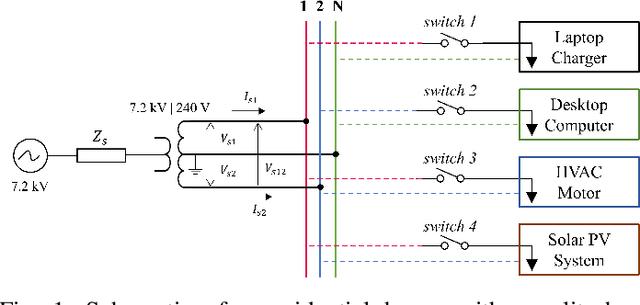



Abstract:Integration of electronics-based residential appliances and distributed energy resources in homes is expected to rise with grid decarbonization. These devices may introduce significant harmonics into power networks that need to be closely studied in order to accurately model and forecast load. However, it can be difficult to obtain harmonic-rich voltage and current data -- necessary for identifying accurate load models -- for residential electrical loads. Recognizing this need, first a set of electronics-based end-use loads is identified and modeled in an electromagnetic transients program tool for a residence. Second, an impedance-varying method is proposed to generate harmonic data that captures harmonic propagation to the supply voltage and harmonic interactions among end-use loads connected to the same supply voltage. Third, a harmonic-rich dataset produced via the proposed methodology is demonstrated to successfully identify frequency coupling matrix-based harmonic load models using the least-squares method. Numerical results demonstrate the accuracy of the model. The impact of limited data availability on model identification is also explored.
Virtual Battery Parameter Identification using Transfer Learning based Stacked Autoencoder
Oct 10, 2018



Abstract:Recent studies have shown that the aggregated dynamic flexibility of an ensemble of thermostatic loads can be modeled in the form of a virtual battery. The existing methods for computing the virtual battery parameters require the knowledge of the first-principle models and parameter values of the loads in the ensemble. In real-world applications, however, it is likely that the only available information are end-use measurements such as power consumption, room temperature, device on/off status, etc., while very little about the individual load models and parameters are known. We propose a transfer learning based deep network framework for calculating virtual battery state of a given ensemble of flexible thermostatic loads, from the available end-use measurements. This proposed framework extracts first order virtual battery model parameters for the given ensemble. We illustrate the effectiveness of this novel framework on different ensembles of ACs and WHs.
Learning Deep Neural Network Representations for Koopman Operators of Nonlinear Dynamical Systems
Nov 17, 2017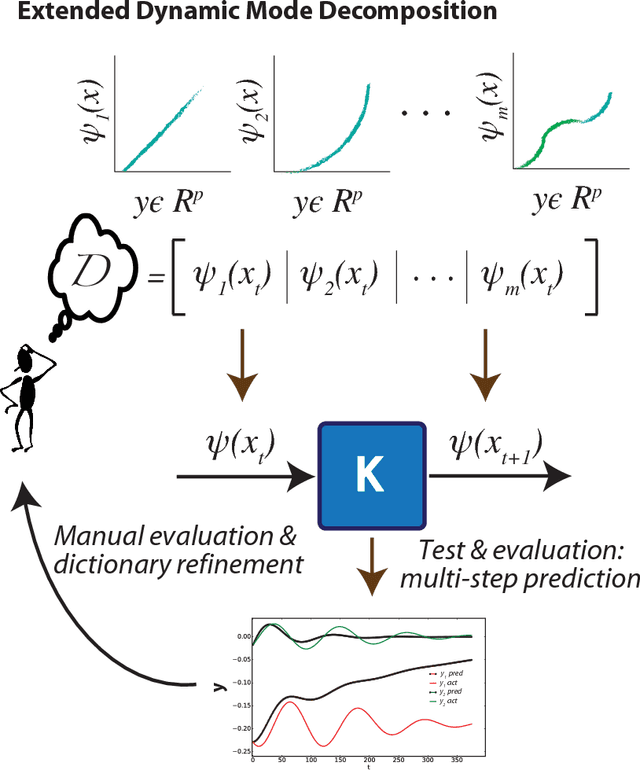
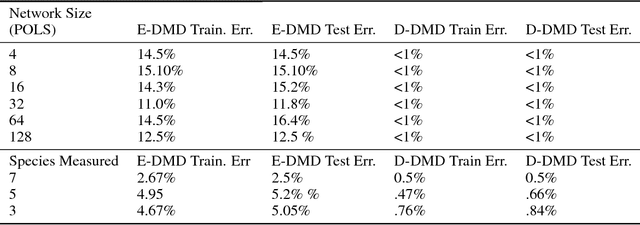
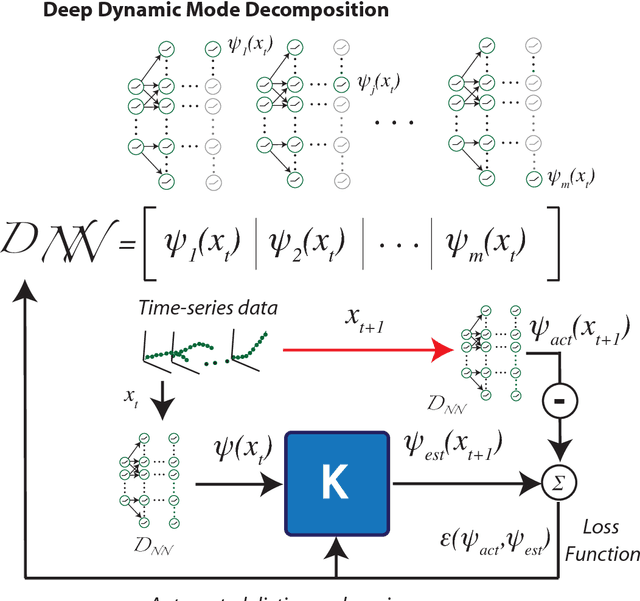
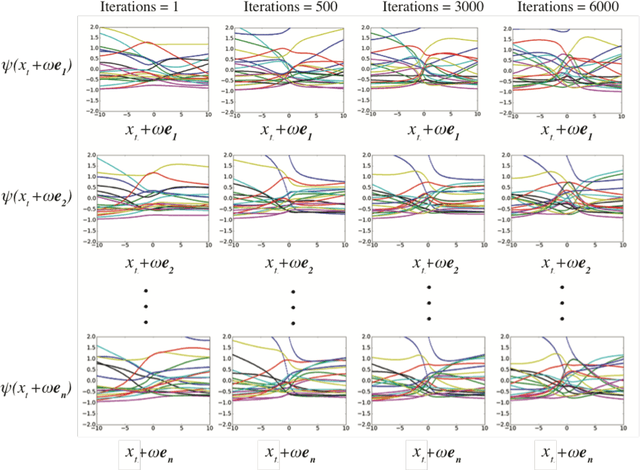
Abstract:The Koopman operator has recently garnered much attention for its value in dynamical systems analysis and data-driven model discovery. However, its application has been hindered by the computational complexity of extended dynamic mode decomposition; this requires a combinatorially large basis set to adequately describe many nonlinear systems of interest, e.g. cyber-physical infrastructure systems, biological networks, social systems, and fluid dynamics. Often the dictionaries generated for these problems are manually curated, requiring domain-specific knowledge and painstaking tuning. In this paper we introduce a deep learning framework for learning Koopman operators of nonlinear dynamical systems. We show that this novel method automatically selects efficient deep dictionaries, outperforming state-of-the-art methods. We benchmark this method on partially observed nonlinear systems, including the glycolytic oscillator and show it is able to predict quantitatively 100 steps into the future, using only a single timepoint, and qualitative oscillatory behavior 400 steps into the future.
Decomposition of Nonlinear Dynamical Systems Using Koopman Gramians
Oct 04, 2017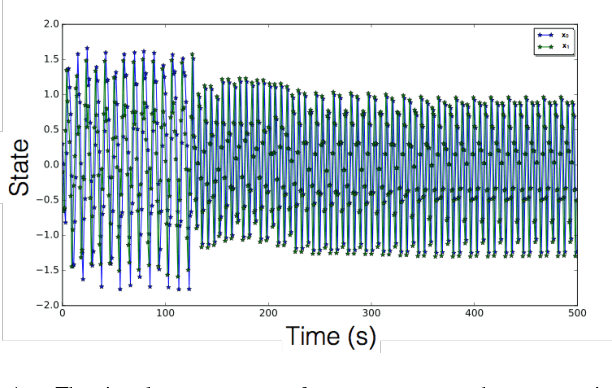
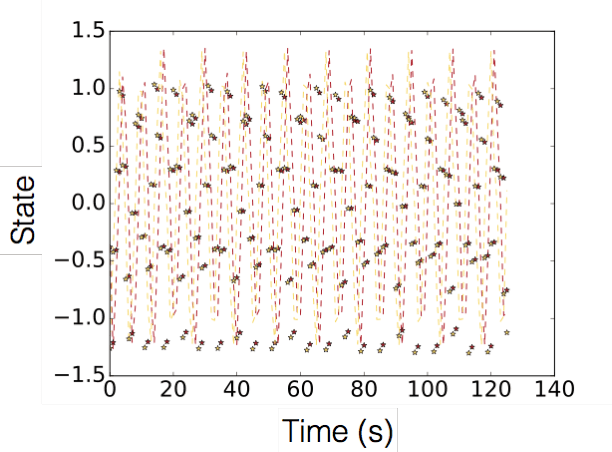
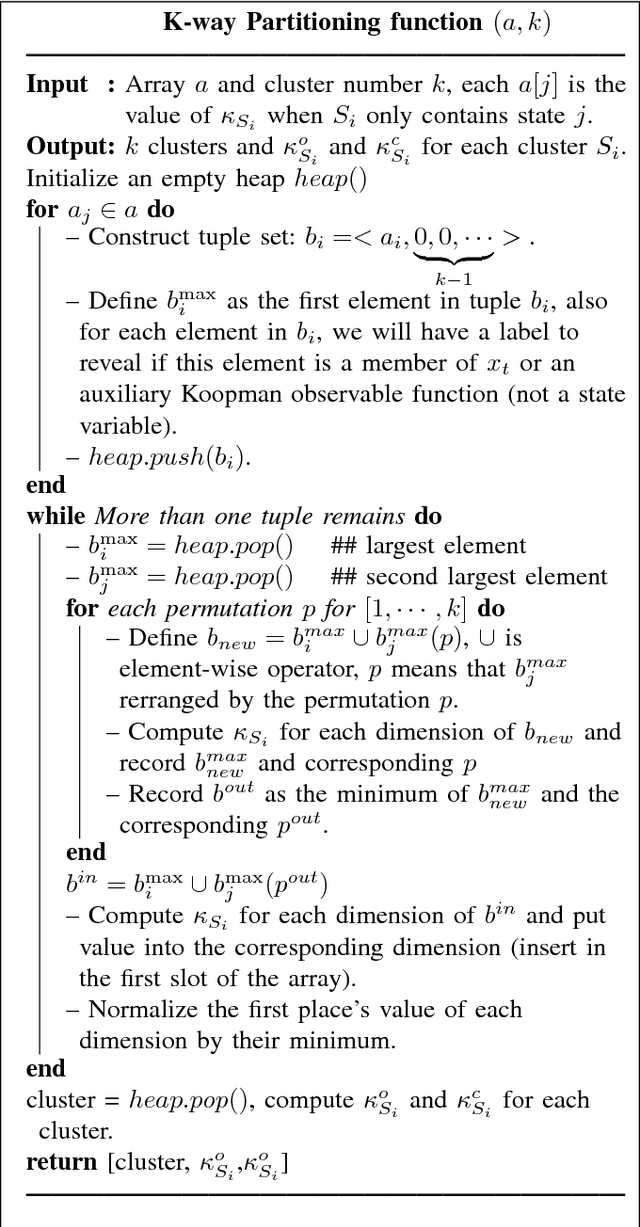
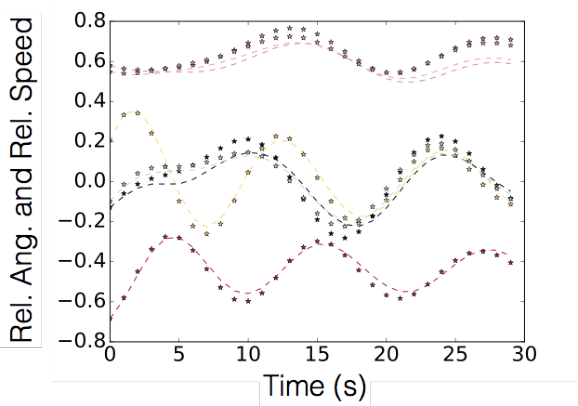
Abstract:In this paper we propose a new Koopman operator approach to the decomposition of nonlinear dynamical systems using Koopman Gramians. We introduce the notion of an input-Koopman operator, and show how input-Koopman operators can be used to cast a nonlinear system into the classical state-space form, and identify conditions under which input and state observable functions are well separated. We then extend an existing method of dynamic mode decomposition for learning Koopman operators from data known as deep dynamic mode decomposition to systems with controls or disturbances. We illustrate the accuracy of the method in learning an input-state separable Koopman operator for an example system, even when the underlying system exhibits mixed state-input terms. We next introduce a nonlinear decomposition algorithm, based on Koopman Gramians, that maximizes internal subsystem observability and disturbance rejection from unwanted noise from other subsystems. We derive a relaxation based on Koopman Gramians and multi-way partitioning for the resulting NP-hard decomposition problem. We lastly illustrate the proposed algorithm with the swing dynamics for an IEEE 39-bus system.
 Add to Chrome
Add to Chrome Add to Firefox
Add to Firefox Add to Edge
Add to Edge